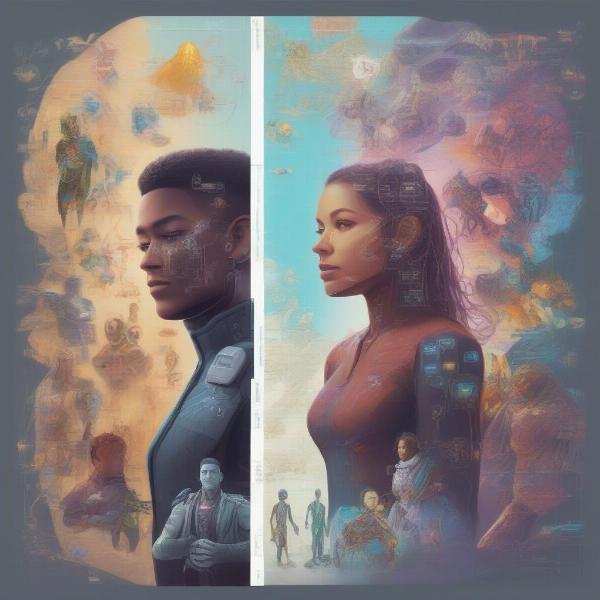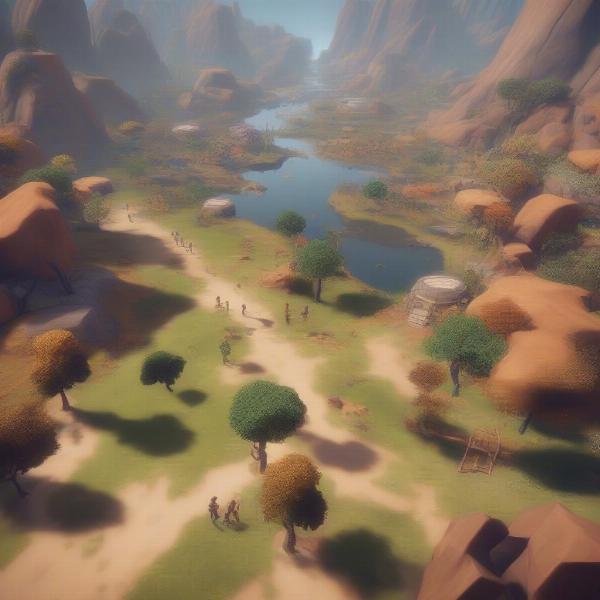The line between AI and human interaction in gaming is blurring. Are you talking to AI or human? This question is becoming increasingly relevant as artificial intelligence continues to evolve and integrate into our favorite pastime. From complex NPCs to automated customer service, AI’s presence is growing, raising questions about the nature of our in-game interactions and the future of gaming experiences.
Decoding the Digital Dialogue: AI vs. Human in Games
Modern games often boast sophisticated AI designed to mimic human behavior. But how can you tell if you’re interacting with a cleverly programmed bot or a real person? Understanding the difference is key to navigating the evolving landscape of online gaming.
Spotting the Bots: Identifying AI in Games
Several telltale signs can help you determine if you’re dealing with AI. Repetitive dialogue, predictable actions, and instantaneous responses are common indicators. AI-driven characters often follow scripted patterns, lacking the spontaneity and nuance of human conversation.
- Repetitive Dialogue: Notice if the character repeats the same phrases or responses in different contexts.
- Predictable Actions: Observe if the character consistently performs the same actions in similar situations.
- Instantaneous Responses: While some humans are quick typers, consistently immediate responses can be a sign of automated systems.
The Human Element: Recognizing Real Players
Human interaction in games brings a unique dynamic. Look for unpredictable behavior, genuine emotion, and nuanced communication. Real players engage in unscripted conversations, make unexpected decisions, and exhibit a range of emotional responses that AI struggles to replicate.
- Unscripted Conversations: Human players engage in free-flowing dialogue, adapting to the context and responding in unpredictable ways.
- Unpredictable Decisions: Humans are prone to making spontaneous choices that deviate from programmed patterns.
- Emotional Range: Real players express a wider range of emotions, from joy and excitement to frustration and anger.
 AI vs Human Interaction in Online Games
AI vs Human Interaction in Online Games
The Impact of AI on Gaming: Enhancing and Evolving the Experience
AI is transforming the gaming landscape, impacting everything from gameplay to social interaction. From enhancing immersion to providing personalized experiences, AI plays an increasingly crucial role.
AI-Powered NPCs: Creating Dynamic and Believable Worlds
AI drives the behavior of non-player characters (NPCs), making game worlds feel more alive and responsive. Sophisticated AI allows NPCs to adapt to player actions, creating dynamic and engaging experiences.
Procedural Generation: Building Vast and Varied Landscapes
AI algorithms can generate vast and diverse game environments, eliminating the need for hand-crafted levels. This opens up possibilities for truly unique and unpredictable gaming experiences.
Personalized Gameplay: Tailoring the Challenge to the Player
AI can analyze player behavior and adjust the game’s difficulty accordingly, providing a personalized and challenging experience. This adaptive AI ensures that players are constantly engaged and never overwhelmed.
 Impact of Artificial Intelligence on Video Games
Impact of Artificial Intelligence on Video Games
The Future of Interaction: Are Humans Becoming Obsolete?
While AI is making remarkable strides, the human element remains vital to the gaming experience. The social connections, collaborative gameplay, and unpredictable nature of human interaction are difficult to replicate.
“AI can enhance the gaming experience, but it cannot replace the unique dynamics of human interaction,” says Dr. Anya Sharma, a leading researcher in AI and gaming at the Interactive Entertainment Institute. “The spontaneous creativity and social connections fostered by human players are irreplaceable.”
The Rise of AI Companions: A New Form of Interaction
AI companions are becoming increasingly popular, offering players a personalized and supportive in-game experience. These AI companions can provide guidance, assistance, and even emotional support. “AI companions can enrich the solo gaming experience by offering a personalized and adaptive form of companionship,” adds Dr. Sharma.
Balancing AI and Human Interaction: The Key to the Future of Gaming
The future of gaming lies in finding the right balance between AI and human interaction. By leveraging the strengths of both, we can create richer, more immersive, and more engaging gaming experiences. “The key is to integrate AI in ways that enhance, rather than replace, the human element,” concludes Dr. Sharma.
 Future of AI and Human Interaction in Gaming
Future of AI and Human Interaction in Gaming
Beyond Gameplay: AI and the Broader Gaming Ecosystem
AI is not just impacting the games themselves but also the wider gaming ecosystem. From customer support to content creation, AI is playing a growing role.
Conclusion: Embracing the Evolving Landscape of Gaming
Are you talking to AI or human? This question will continue to shape the gaming experience as AI technology advances. Embracing the evolving landscape and understanding the interplay between AI and human interaction will be key to enjoying the future of gaming. Share your thoughts and experiences in the comments below!
FAQ
- How can I tell if I’m talking to an AI in a game? Look for repetitive dialogue, predictable actions, and instantaneous responses.
- What are the benefits of AI in gaming? AI can enhance immersion, personalize gameplay, and create dynamic game worlds.
- Will AI replace human players in the future? While AI is evolving rapidly, the unique aspects of human interaction remain irreplaceable.
- What are AI companions? AI companions are personalized in-game assistants that provide guidance and support.
- How can I learn more about AI in gaming? Stay updated on industry news and research related to AI and game development.
- What are some examples of games using advanced AI? Many modern games utilize AI for NPC behavior, procedural generation, and personalized gameplay.
- What is the future of AI in gaming? The future likely involves a balanced approach, integrating AI to enhance rather than replace human interaction.

